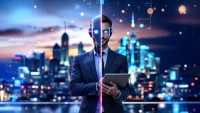The debate between AI and human capabilities isn’t about picking sides—it’s about strategic synergy. Forward-thinking entrepreneurs don’t see technology as a replacement for human ingenuity but as a powerful collaborator.
From automating repetitive tasks to enhancing creative decision-making, the fusion of artificial intelligence and human expertise unlocks unprecedented opportunities. This guide explores how successful leaders harness both to scale operations, improve customer experiences, and stay ahead of competitors.
Table of Contents
ToggleWhy the AI vs. Human Debate Misses the Point
The most innovative businesses don’t treat AI and human talent as rivals—they integrate them strategically:
- AI excels at: Data analysis, automation, and scalability.
- Humans excel at: Creativity, emotional intelligence, and complex problem-solving.
The real competitive advantage lies in combining these strengths.
Where AI Outperforms Humans (And Where It Doesn’t)
AI’s Unmatched Strengths
- Data Processing: Analyzes vast datasets in seconds (e.g., market trends, customer behavior).
- 24/7 Efficiency: Handles repetitive tasks (chatbots, invoicing) without fatigue.
- Predictive Analytics: Forecasts sales, inventory needs, and risks with high accuracy.
Where Humans Still Dominate
- Emotional Intelligence: Builds trust, negotiates, and understands nuanced customer needs.
- Innovation: Generates original ideas, adapts to unexpected challenges.
- Ethical Judgment: Makes morally complex decisions AI can’t replicate.
How Entrepreneurs Leverage AI for Growth
Automating Routine Operations
- Customer Service: AI chatbots handle FAQs, freeing staff for high-touch issues.
- Accounting: Tools like QuickBooks Auto categorizes expenses and generates reports.
- Inventory Management: AI predicts demand spikes, preventing stockouts.
Enhancing Data-Driven Decisions
- Marketing: AI analyzes ad performance, optimizing campaigns in real time.
- Hiring: Algorithms scan resumes for top candidates, reducing bias in initial screenings.
Personalizing Customer Experiences
- Recommendation Engines (e.g., Netflix, Amazon) boost sales by suggesting relevant products.
- Dynamic Pricing: AI adjusts prices based on demand, competition, and buyer behavior.
The Irreplaceable Human Touch in Business
Building Authentic Relationships
AI can’t replicate the trust and loyalty forged through genuine human interaction. Examples:
- High-value sales requiring relationship-building.
- Crisis management where empathy is critical.
Creative Strategy & Leadership
Humans drive:
- Brand storytelling that resonates emotionally.
- Adaptive leadership during uncertain times (e.g., market shifts).
Ethical Oversight
AI lacks moral reasoning. Humans must:
- Audit AI biases (e.g., hiring algorithms favoring certain demographics).
- Ensure compliance with regulations like GDPR.
Case Studies: Companies Winning with AI-Human Collaboration
Starbucks
- AI: Predictive analytics suggest personalized drink recommendations via its app.
- Human: Baristas create the experience—remembering names, crafting handmade beverages.
Spotify
- AI: Algorithms curate personalized playlists (Discover Weekly).
- Human: Music experts design mood-based playlists (e.g., “Peaceful Piano”).
Zappos
- AI: Chatbots handle simple returns.
- Human: Customer service reps famously spend hours building rapport with shoppers.
How to Implement AI Without Losing the Human Edge
Audit Your Workflow
Identify tasks best suited for AI (e.g., data entry) vs. those needing human judgment (e.g., client strategy).
Upskill Your Team
Train employees to:
- Work alongside AI tools (e.g., interpreting analytics dashboards).
- Focus on high-value creative/strategic work.
Maintain Transparency
Customers appreciate knowing when they’re interacting with AI versus humans—build trust through clarity.
The Future: AI as a Collaborative Partner
Emerging trends show AI evolving into a “co-intelligence” model:
- Generative AI drafts content, but humans refine tone and strategy.
- AI-assisted brainstorming suggests ideas, teams select and expand the best ones.
The businesses that thrive will blend AI’s speed with human wisdom.
FAQs About AI and Human Collaboration
Will AI Replace Jobs?
It will transform roles, not eliminate them. For example, accountants using AI shift from data entry to financial strategy.
How Can Small Businesses Afford AI?
Start with low-cost tools like ChatGPT (free tier), Canva’s AI design features, or HubSpot’s automation.
Can AI Understand Cultural Nuances?
Not fully. Humans must review AI-generated content for local slang, humor, or sensitivities.
What’s the Biggest Risk of Over-Reliance on AI?
Losing customer trust if interactions feel impersonal or algorithms make tone-deaf decisions.
How Do I Measure AI’s ROI?
Track metrics like time saved, error reduction, sales uplift from personalization, and customer satisfaction scores.
Final Thoughts: The Winning Formula
The most successful entrepreneurs don’t fear AI—they harness its power while doubling down on human strengths. By letting AI handle repetitive tasks and data crunching, you free up time for innovation, relationship-building, and strategic thinking.
Ready to integrate AI into your business? Start with one tool, measure its impact, and scale what works—while keeping your team’s creativity at the core.
Internal Links:
- The AI Tools Entrepreneurs Swear By to Streamline Success
- How AI is Enabling Entrepreneurs to Automate and Scale Effortlessly
External Links:



















